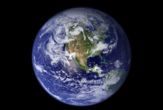New View of Early Earth: A Habitable Place

There are a trio of longstanding views of what Earth might have looked like in its formative years: a moon-like desert, a fiery volcanic hell, or a waterworld with no firm footing.
All three may be wrong.
A new study concludes Earth had continents and oceans 4.3 billion years ago, which is just a geological eyeblink after the planet is thought to have formed, in the wake of the Sun's birth 4.6 billion years ago.
A separate study reported in May came to a similar conclusion, also suggesting that notions of a fiery, hellish planet back then have been overblown.
Here's why it matters: A world with water and land and somewhat moderate temperatures and volcanic conditions would have been habitable. That does not mean there was life, but the conditions were in place.
Picture this
The new study was reported this week in the online version of the journal Science. University of Colorado researcher Stephen Mojzsis explained what our world might have looked like back then:
"Before 4 billion years ago, the Earth would not be recognizable for the Pale Blue World that we are familiar with today. Indeed, although we now understand that there were significant landmasses already present by that time, the denser carbon dioxide-rich atmosphere would have given the sky a reddish-tinge," Mojzsis told LiveScience.
Sign up for the Live Science daily newsletter now
Get the world’s most fascinating discoveries delivered straight to your inbox.
"The oceans, with a much higher concentration of iron than our contemporary oceans, would look a dark greenish-blue and these oceans would have bathed hundreds of small continents akin to New Zealand or the Japan arc," he said.
The conclusion is based on an analysis of hafnium, a rare element in ancient minerals from the Jack Hills in Western Australia. The rocks are thought to be among the oldest on Earth, dated to 4.4 billion years ago.
"The evidence indicates that there was substantial continental crust on Earth within its first 100 million years of existence," Mojzsis said.
Perfect for microbes
The research, led by Mark Harrison of the Australian National University, builds on work Mojzsis and colleagues reported in 2001 that showed evidence for water on Earth's surface roughly 4.3 billion years ago.
"The view we are taking now is that Earth's crust, oceans and atmosphere were in place very early on, and that a habitable planet was established rapidly," Mojzsis said.
The air would have been an unbreathable mix of carbon dioxide, water vapor, sulfur gases and methane. Yet for many microbes, "this is the preferred environment," Mojzsis points out.
Scientists do not know exactly when life began or how it got started. If it did begin 4.3 billion years ago, it may have been wiped out by space rock impacts, only to start up again, other theorists say. At any rate, Earth was a treacherous place for the first billion years or so, until it had helped scoop up many of the asteroids and comets that filled the early solar system.
Robert is an independent health and science journalist and writer based in Phoenix, Arizona. He is a former editor-in-chief of Live Science with over 20 years of experience as a reporter and editor. He has worked on websites such as Space.com and Tom's Guide, and is a contributor on Medium, covering how we age and how to optimize the mind and body through time. He has a journalism degree from Humboldt State University in California.










